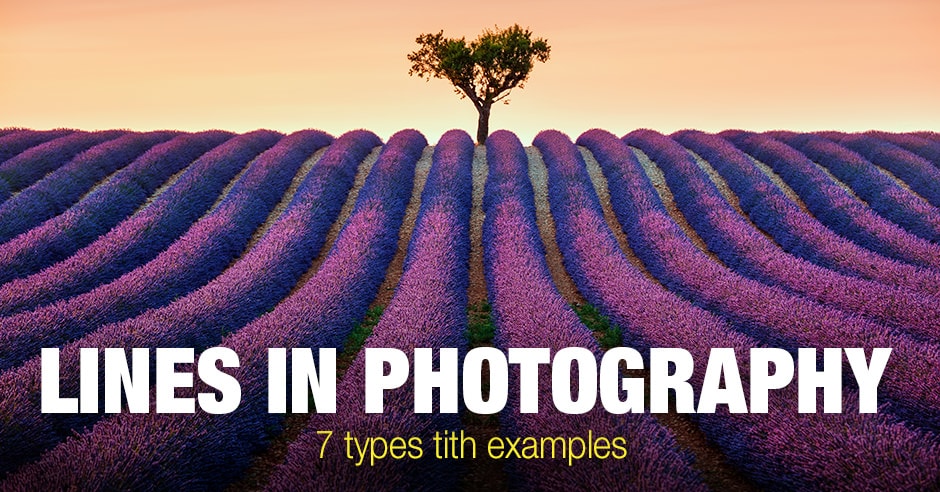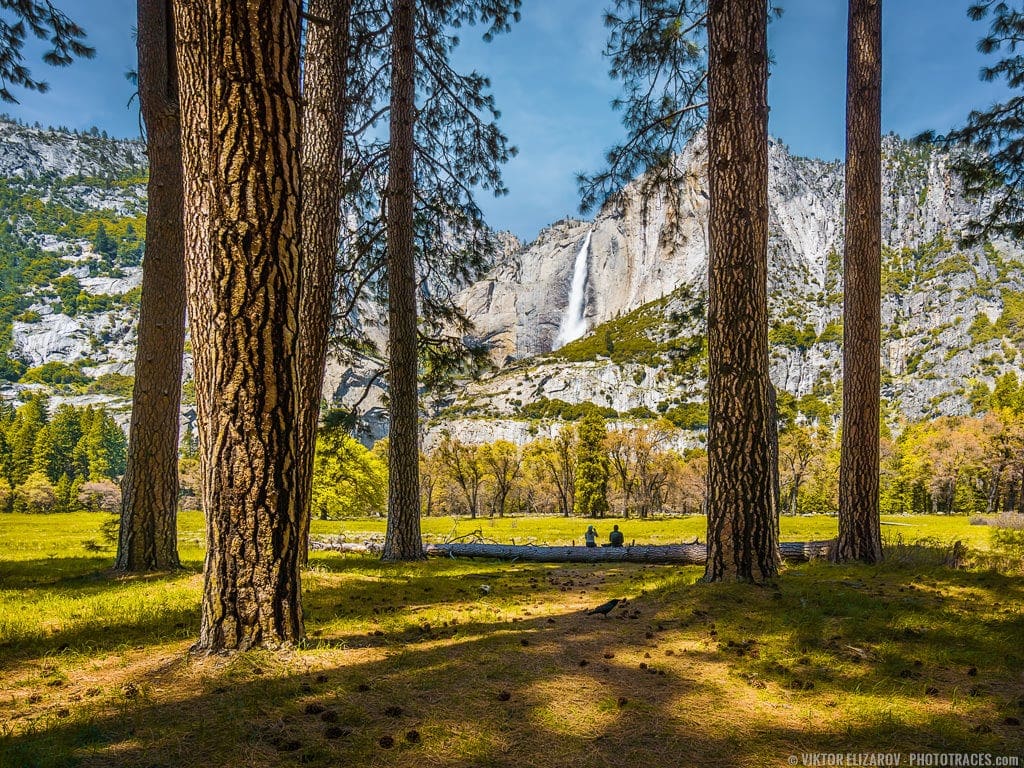If you want to create stunning compositions, you must be familiar with lines in photography.
You see, lines are a fundamental element of composition–and they’re one of the easiest ways to draw the viewer into your photos, add depth, guide the viewer around, and much more.

Without lines, most photos would be boring.
But by learning to master lines, you can take your photos to the next level.
Do you want to know how lines work in photography?
Then keep reading.
What Is a Line in Photographic Composition?
A line refers to anything that stretches between two points in your photo.
So a line can be a fallen tree, a moving river, or even a slew of rocks leading off into the distance.
Note that lines are a fundamental part of photography (for more on lines and other concepts as fundamental parts of photography, please see my article on the elements and principles of photography).
Why are lines so fundamental?
Because pretty much everything is made up of lines, from houses to trees to people and more. It’s not only photographers who love lines; painters love lines, too, as do graphic designers and more. Lines are great–and by carefully learning how to use them, you can get consistently great results.
Now, it’s pretty tough to take a photo without any lines at all.
However, it’s easy to take a photo that ignores the types and configurations of lines you have in your scene.
Ultimately, ignoring lines will lead to a bad image.
Make sense?
So identify your lines and use them deliberately!

Why Are Lines Important in Photography?
Lines are essential parts of photography for a few reasons.
First, lines lead the eye. In other words, they guide the viewer through the frame, taking them from area to area to area. This occupies the viewer (always a good thing!), plus it helps create tension and flow (which is always a strong idea in serious photography.
Second, lines create depth. If you have a special type of line–called leading lines–you can draw the viewer in at the foreground, then force them up and into the middleground and ultimately the background. Leading lines only work because they’re positioned carefully in the foreground; that way, they can catch the viewer’s attention, pull them in, and take the viewer on a journey around the shot.
Third, lines can convey different messages. Thick, strong lines make the image feel powerful, whereas weedy, wispy lines make the image feel fragile.

What Are the Types of Lines in Photography?
Generally speaking, there are seven types of lines in photography you need to become familiar with, especially if you’re eager to create stunning compositions.
I’m going to take you through each one, starting with:
1. Horizontal Lines
Horizontal lines are a fundamental element in various types of photography, including landscape photography.
These lines, which run parallel to the horizon or the frame’s bottom edge, extend from left to right or vice versa and profoundly affect a photo’s composition.
Images with horizontal lines often evoke stability and calm. They are commonly linked to feelings of tranquility and can impart a sense of balance and symmetry within the frame. These lines can section off parts of the image or highlight the expansiveness of a landscape.
Horizontal lines also communicate characteristics of the environment or subject. In architectural shots, for instance, they can underscore the solidity of a structure.
Emotionally, horizontal lines can be quite powerful: a tranquil seascape with a level horizon can instill peace, whereas straight lines of power lines might suggest tension.

In summary, horizontal lines are vital for creating stability, balance, and tranquility in photographic composition. They are a key consideration for photographers aiming to craft images with specific visual and emotional impacts.
How to Use Horizontal Lines
When it comes to horizontal lines, I’d recommend starting with the horizon, which should be placed horizontally in the frame.
You’ll want to carefully position the horizon line in your composition; if you have a dramatic sky, try placing the horizon on the lower-third gridline, and if your sky is pretty bland, then place the horizon on the upper-third gridline.
You can generally use the rule of thirds or golden ratio to position horizontal lines, and you’ll get good results; it’s an area where the rule of thirds does an excellent job.
2. Vertical Lines
Vertical lines are lines that run up and down within a frame, perpendicular to the horizon. These lines can be either straight or curved, and like horizontal lines, they greatly influence the structure and emotion of an image.
Vertical lines are often associated with a sense of strength, stability, and height. When included in an image, they can make subjects appear taller, emphasizing their grandeur or significance.
For example, capturing towering skyscrapers, towering trees, or tall structures against the sky often employs upright lines to underline their imposing nature.
Incorporating vertical lines can help photographers achieve a sense of balance and symmetry in their compositions. By aligning key elements along vertical lines, they can create a harmonious and well-proportioned visual experience. This is particularly useful when photographing architectural structures, where straight vertical lines contribute to a feeling of order and precision.
Vertical lines often manifest in patterns and textures, such as a row of doors, pillars, or columns. These patterns can add visual interest and depth to a photograph. Capturing the repetition and rhythm of vertical lines within a scene can create a mesmerizing visual effect.

Whether employed to convey strength, symmetry, or emotion, photographers have a wide array of creative possibilities at their disposal when incorporating upright lines into their compositions.
How to Use Vertical Lines
While vertical lines aren’t as common as horizontal lines in landscape photography, you’ll still be given the opportunity to include a vertical line or two in your compositions.
For instance, trees offer very straight verticals, and you can use these to point the viewer up through the frame or to give the composition some extra stability.
If the vertical line is part of a foreground object, one thing to bear in mind is that you can often reposition it within your composition to become diagonal or some other line type. So don’t feel like you’re stuck with the line you initially noticed!
3. Diagonal Lines
Diagonal lines are a dynamic force in photography composition, imbued with tension and vitality. I personally favor diagonal lines as they inject an image with a sense of energy, compelling the viewer to stay engaged and explore the photo further.
These lines cut across the frame at an angle, creating movement and direction. Often, you’ll notice that leading lines — the ones that draw your eye through the photograph — are diagonal. This is because diagonals keep the eye moving, providing a natural flow that guides the viewer effortlessly from one element to another.

In comparison to the more static vertical and horizontal lines, diagonal lines offer a compelling alternative. They instill a composition with a sense of action and progression that is less overt in images dominated by verticality or horizontality.
Diagonal lines also excel in creating a natural look within an image. While straight vertical or parallel lines can sometimes seem artificially imposed or overly rigid, diagonal lines follow a more organic path that echoes the irregularities found in nature and human-made environments.
How to Use Diagonal Lines
Diagonal lines in landscape photography can be found in various natural formations and man-made structures:
- The angle of a hillside or a mountain slope often creates a diagonal line in the frame, adding a sense of dimension and grandeur to the landscape.
- The winding path of a river or stream cutting across a scene forms a diagonal that can lead the viewer’s eye from one part of the image to another, creating a pathway for exploration within the photo.
- The limbs of trees or logs lying across the forest floor can introduce diagonals, often creating interesting patterns or leading lines that draw attention to key elements.
I’d recommend you start by locating some interesting foreground lines. Then see if you can fit them diagonally into the composition. I like to position diagonals, so the line begins just around one corner of the frame and ends just opposite the other corner.

By carefully positioning the diagonals within the frame, you can ensure that the viewer moves in the right direction. I’d recommend keeping the diagonals in service to the main subject; it’s a bad idea to create interesting diagonals if those diagonals take you off into a boring distance with no other compelling elements to highlight.
4. Converging Lines
Converging lines are a powerful compositional element that draws the viewer’s gaze into the depth of the frame, often leading toward a single vanishing point. These lines typically stretch across the image and appear to converge as they recede into the distance.
Most commonly, converging lines give the impression of meeting at infinity, beyond the boundaries of the photograph. In such cases, the actual point of convergence isn’t visible within the image; instead, the viewer’s imagination is engaged to visualize the continuation of the lines as they taper off into the horizon.
There are, however, scenarios where converging lines do intersect within the confines of the frame. When you find these opportunities, they can serve as a particularly striking compositional feature, reinforcing the structure and depth of the scene.
For the strongest impact, converging lines should ideally lead toward or frame the main subject of the image. This directs the viewer’s attention precisely where you want it and strengthens the subject’s presence within the composition.
Conversely, if the convergence point is too distant or disconnected from the primary subject, the lines risk becoming a competing element of visual interest, pulling the viewer’s eye away from the central focal point. This can result in a distraction rather than an enhancement to the composition.

How to Use Converging Lines
You can find converging lines everywhere in landscape photography, especially if you’re using an ultra-wide lens.
- For instance, cavern walls seem to converge inward. Foreground elements lead the eye in and converge on the background. Mountain peaks converge on one another.
- A straight road, a winding path, or a trail through a forest can serve as converging lines.
- Bodies of water like rivers and streams naturally draw the eye along their course, and their banks provide lines that can lead to a stunning waterfall, a mountain range, or a horizon.
- The shoreline of a beach can provide a subtle converging line, especially when looking at an angle towards the sea
As soon as you identify possible converging lines, I’d recommend you try to figure out the subject you want to use as your focal point. Then, once everything has come together, both compositionally and technically, take the shot.
5. Curved Lines
Curved lines often convey a sense of peacefulness and harmony, owing to their gentle and graceful nature. Unlike the directness of straight lines, curves offer a leisurely path through the image, inviting viewers to explore the photograph in a more relaxed and meandering way.
For example, the natural winding course of a river, as it extends into the distance, demonstrates how a curve can lead the eye through a scene. Similarly, the outline of a lake viewed from an elevated position can form a pleasing curved shape within the landscape. These curved lines mimic the flow of water, symbolizing life’s rhythm and continuity.
Curves not only add movement to composition but also provide a means to engage viewers by directing them around and through the scene.
However, an overabundance of curves or curves that lack direction and purpose can be disorienting and can detract from the photo’s focal point. A well-placed curve, on the other hand, can serve effectively as a leading line, guiding the viewer from a prominent element in the foreground to a subject of interest in the background.

A practical technique for leveraging the allure of curves is to utilize the golden spiral compositional rule. This spiral shape is based on the golden ratio, a mathematical principle known for its aesthetic harmony. By arranging the curve of your subject in accordance with the golden spiral, you can enhance the visual flow and overall appeal of the composition.
How to Use Curved Lines
Curved lines aren’t especially different from horizontal or vertical ones; you should treat them like they always guide the viewer, and you’ll do just fine.
For instance, you can use a river in the shape of an S-curve to guide the viewer along a meandering path, from foreground to middleground to background. In fact, you may have heard of the S-curve, because it’s just that popular! You can also use the edge of a pond to create a beautiful curved shot, or the curvaceous edge of mountain peaks to create a set of curved layers.
6. Leading Lines in Photography
Leading lines are a compositional technique favored by landscape photographers and used across various photographic genres. These lines serve as visual guides that draw the viewer’s eye into the image, creating a journey from the foreground through the middleground and into the background.
Typically diagonal or vertical, leading lines function as pathways within an image, offering viewers a narrative thread to follow and adding a sense of depth to the scene. A well-constructed leading line not only provides directional flow but also enhances the three-dimensionality of the image by emphasizing spatial relationships.
While the classic implementation of leading lines involves a transition from the immediate foreground to the distant background, this is not a rigid requirement. In some compositions, leading lines may begin at the edge of the frame and direct attention towards the center, or they may guide the eye from a close foreground element to a feature that is slightly further away.
The effectiveness of leading lines lies in their ability to simplify the visual journey inside a photograph. By drawing attention to specific points of interest or directional cues, leading lines can transform an ordinary scene into a compelling visual story.

How to Use Leading Lines
First, identify your leading lines. You might use a river (these are very popular), a path (also popular!), or a fallen log.
Then position the leading line in the foreground, guiding the viewer toward the middleground and the background.
Your leading line doesn’t need to be completely straight, nor should it be vertical; instead, the line should have some character and move diagonally across the composition.
7. Implied Lines
Implied lines refer to lines that the viewer’s brain constructs, although they don’t exist within the image. These lines form from a visual connection between separate elements that your eye naturally follows, guiding your gaze through the photograph.
Consider how we perceive constellations in the night sky: while no physical lines connect the stars, our minds create lines that draw a pattern, linking them to form recognizable shapes and figures.
Implied lines manifest in various ways within a photograph. They might originate from a subject’s gaze or the direction in which an object points. For example, one of the most powerful suggested lines is the direction in which a subject is looking. If a person in a photo is looking toward the left, an implied line draws the viewer’s eye in that direction, possibly to another subject or to the edge of the frame, suggesting something lies beyond.
Photographers can intentionally leverage implied lines to create a sense of movement, direct attention to a specific focal point, or impart a narrative quality to the image. By carefully arranging subjects, using natural features, or positioning contrasting elements within the frame, photographers craft intricate visual paths that captivate viewers, effectively communicating through silent visual cues.
Implied lines represent an advanced compositional technique that can greatly enhance the impact of an image.

How to Use Implied Lines
Implied lines can be kind of tricky to use because you have to estimate their impact and carefully place them within your composition.
I recommend letting your implied lines work as any of the options described above, including leading, horizontal, or diagonal lines. After all, a line can be both implied and leading or implied and horizontal.
One thing to remember, though, is that an implied line is rarely stronger than an actual, physical line. So it’s easy to destroy your compositions by including a weak implied line and expecting it to be strong.
Lines in Photography | Conclusion
Mastering lines in photography may seem difficult, especially considering the sheer volume of lines to choose from.
That said if you remember the advice from this article…
And you practice regularly…
…you’ll be doing great in no time at all!

